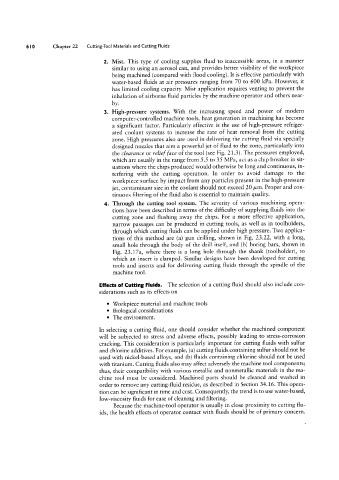Page 629 - 04. Subyek Engineering Materials - Manufacturing, Engineering and Technology SI 6th Edition - Serope Kalpakjian, Stephen Schmid (2009)
P. 629
0 Chapter 22 Cutting-Tool Materials and Cutting Fluids
2. Mist. This type of cooling supplies fluid to inaccessible areas, in a manner
similar to using an aerosol can, and provides better visibility of the workpiece
being machined (compared with flood cooling). It is effective particularly with
water-based fluids at air pressures ranging from 70 to 600 kPa. However, it
has limited cooling capacity. Mist application requires venting to prevent the
inhalation of airborne fluid particles by the machine operator and others near-
by.
3. High-pressure systems. With the increasing speed and power of modern
computer-controlled machine tools, heat generation in machining has become
a significant factor. Particularly effective is the use of high-pressure refriger-
ated coolant systems to increase the rate of heat removal from the cutting
zone. High pressures also are used in delivering the cutting fluid via specially
designed nozzles that aim a powerful jet of fluid to the zone, particularly into
the clearance or reliefface of the tool (see Fig. 21.3). The pressures employed,
which are usually in the range from 5.5 to 35 MPa, act as a chip breaker in sit-
uations where the chips produced would otherwise be long and continuous, in-
terfering with the cutting operation. In order to avoid damage to the
workpiece surface by impact from any particles present in the high-pressure
jet, contaminant size in the coolant should not exceed 20 um. Proper and con-
tinuous filtering of the fluid also is essential to maintain quality.
4. Through the cutting tool system. The severity of various machining opera-
tions have been described in terms of the difficulty of supplying fluids into the
cutting zone and flushing away the chips. For a more effective application,
narrow passages can be produced in cutting tools, as well as in toolholders,
through which cutting fluids can be applied under high pressure. Two applica-
tions of this method are (a) gun drilling, shown in Fig. 23.22, with a long,
small hole through the body of the drill itself, and (b) boring bars, shown in
Fig. 23.17a, where there is a long hole through the shank (toolholder), to
which an insert is clamped. Similar designs have been developed for cutting
tools and inserts and for delivering cutting fluids through the spindle of the
machine tool.
Effects of Cutting Fluids. The selection of a cutting fluid should also include con-
siderations such as its effects on
° Workpiece material and machine tools
° Biological considerations
° The environment.
In selecting a cutting fluid, one should consider whether the machined component
will be subjected to stress and adverse effects, possibly leading to stress-corrosion
cracking. This consideration is particularly important for cutting fluids with sulfur
and chlorine additives. For example, (a) cutting fluids containing sulfur should not be
used with nickel-based alloys, and (b) fluids containing chlorine should not be used
with titanium. Cutting fluids also may affect adversely the machine tool components;
thus, their compatibility with various metallic and nonmetallic materials in the ma-
chine tool must be considered. Machined parts should be cleaned and washed in
order to remove any cutting-fluid residue, as described in Section 34.16. This opera-
tion can be significant in time and cost. Consequently, the trend is to use water-based,
low-viscosity fluids for ease of cleaning and filtering.
Because the machine-tool operator is usually in close proximity to cutting flu-
ids, the health effects of operator contact with fluids should be of primary concern.

